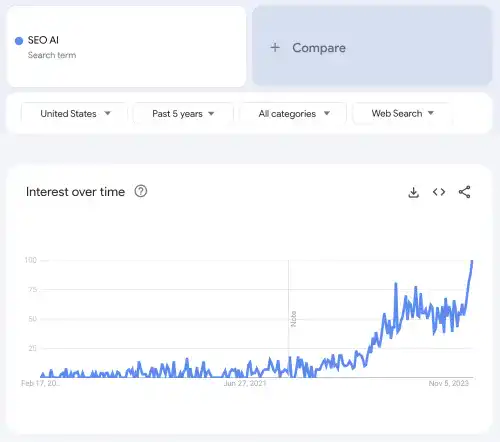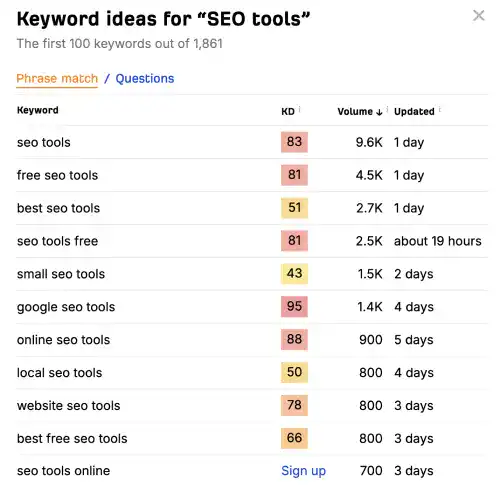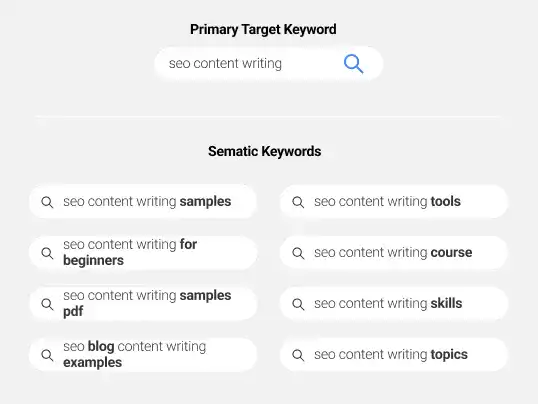Step-by-Step Guide to Keyword Research

There are four or five key steps for keyword research. The last step is keyword optimization activities, which will be covered in more detail in the following chapters.
- Define the objectives of keyword research
- Set a seed keyword
- Expand keyword ideas and analyze them using keyword planning tools
- Select target keywords
- Use the target keywords in SEO activities
1. Define the objectives of keyword research
Defining the objectives of keyword research is critical to conducting keyword research effectively. Depending on the objectives, priority keywords can be different.
Conversion vs. traffic
If the website is an e-commerce site, the objective is to sell products (conversion). In this case, you want to get users who intend to buy the type of products you are selling.
If the website is part of web media and does not intend to sell any products or services, the objective can be gaining user traffic.
Specific web page vs. entire website
If you are doing keyword research for one web page, you need to define one primary keyword with some secondary keywords for the page.
However, if you are doing keyword research for the entire website with multiple pages, you need to create sets of keywords and map them to each web page.
2. Set a seed keyword
Once the objectives are defined clearly, you need to set a seed keyword.
If you have a content outline, seed keywords should naturally emerge. For example, if you are selling "cat food," "cat food" is the seed keyword.
There may be some seed keyword candidates when there are different expressions for similar concepts—for example, "coffee shop" or "café."
In that case, you need to analyze both seed keywords in parallel.
3. Expand keyword ideas and analyze them using keyword planning tools
The next step is expanding keyword ideas and analyzing them.
Several free and paid tools help expand keyword ideas using critical data, such as Monthly Search Volume and Keyword Difficulty (or competition level).
Google Keyword Planner
Google Keyword Planner is a free tool provided on the Google Ads platform.
To use this tool, go to the Google Ads platform. Click the Tool menu on the left sidebar. Under the Planning section, you can find the Keyword Planner.
This tool gives you monthly search volume with numbers; however, competition information is qualitative only (Low, Medium, and High). If you want to know more details about competition or keyword difficulty, you need to consider other tools.

Google Ads is available here.
Google Trends
Google Trends is a free web tool that allows you to check keyword search volume trends for a specified time frame.
This tool can be especially powerful when you want to see a search volume trend or identify hot keywords (rising keywords); however, this tool doesn't provide keyword difficulty or competition information. For example, the screenshot below shows that the keyword "SEO AI" search volume has been rising.

Google Trends is available here.
Other Free Tools
Some free tools, such as Ahref Free Keyword Generator and Moz Keyword Explorer, provide more information about keyword difficulty.
By using these tools, you can get more granular information. However, the data you can get from them is limited compared to paid tools.
ahrefs Free Keyword Generator

ahref’s Free Keyword Generator is available here.
Moz Keyword Explorer

Moz Keyword Explorer is available here.
Paid Tools
For a more robust keyword analysis, you should consider signing up for paid tools like Semrush, Ahref, and Moz Pro.
They provide more comprehensive keyword analysis information with additional features, such as target keyword recommendations.
As these tools provide other SEO features, including site audit and backlink analysis, you should consider their benefit in terms of overall SEO productivity improvement.
Semrush Keyword Research Tools

4. Select target keywords
Once you have a long list of target keyword candidates, you need to prioritize them and select target keywords based on supporting facts, such as volume, keyword difficulty, and alignment with objectives.
One primary target keyword for one page
In most cases, your web page competes with other existing web pages, and top-ranked pages result from massive SEO efforts by their page owners. If you want your web page to get in the top 10 on the SERP (Search Engine Result Page), your efforts should be concentrated on a specific target.
Ultimately, your page may be ranked for multiple keywords; however, starting from one primary target keyword (or keyword phrase) is better. Setting multiple target keywords or phrases complicates your SEO strategy, especially if you are an SEO beginner and your website is new.
If your website has multiple pages, you should prepare multiple primary keywords and assign them to each page.
Start from long- or mid-tail keywords
As explained earlier, targeting short-tail keywords from the very beginning is usually challenging. Short-tail keywords can generate a lot of traffic as their search volume is generally very high; however, the competition level to get a higher page rank is also high.
If your website is new, target long-tail keywords or mid-tail keywords first.
Incorporating Semantic Keywords as Secondary Targets
As search engine algorithms evolve, they increasingly prioritize content that provides useful information related to the user's search queries. Within the SEO framework, semantic keywords are terms or phrases that are contextually linked to the primary target keyword. These keywords enrich the content and enhance relevance, aiding in delivering more comprehensive information to users.
If you have expertise in the subject, you might instinctively think of relevant semantic keywords. However, your intuitive choices might not always align with actual user search behaviors.
To accurately identify semantic keywords, consider using search engines in addition to traditional keyword planning tools. For instance, if your primary target keyword is "SEO Content Writing," simply entering this term into Google's search bar can reveal frequently searched related keywords. These typically appear in the middle section of the search results page, offering direct insights into user interests.

For a deeper understanding of semantic keywords, including how to effectively pinpoint them, refer to the detailed guide on Semantic Keywords: What They Are & How to Find Them.
Note: LSI (Latent Semantic Indexing) Keywords
LSI (Latent Semantic Indexing) Keywords were previously used in SEO content writing, and they are still helpful in identifying semantic keywords; however, using LSI keywords is not mandatory in recent SEO content writing.
LSI is a relatively old technology, and Google now applies various approaches to identify semantic keywords.
You can check this article to better understand the latest LSI status – What Are LSI Keywords & Why They Don‘t Matter.
5. Use the target keywords in SEO activities
The keyword research results are primarily used for on-page SEO, but they are also crucial for off-page SEO to define key sources for off-page SEO activities.

On-Page SEO
Once you set target keywords (primary and secondary), you need to optimize content using the keywords for on-page SEO.
Steps to optimize content are different between single-page optimization and multiple-page optimization.
Single page optimization
For the single-page optimization, you need to do keyword placement, which is the strategic positioning of the target keywords in specific locations in the HTML document.
To learn this topic in detail, go to Chapter 9. SEO Content Writing.
Multiple page optimization
Suppose you optimize multiple pages, like optimizing the entire website. In that case, you need to do keyword mapping, which is strategically assigning target keywords to each web page before placing keywords on each page.
To learn this topic in detail, go to Chapter 10. Organizing Multi-Page Content.

Off-Page SEO
The defined target keywords are crucial for setting directions for off-page SEO by guiding strategies for backlink building, content marketing, and social media campaigns.
They help identify relevant platforms for acquiring valuable backlinks and inform content creation for guest blogging and social posts, ensuring alignment with the audience's interests.
To learn this topic in detail, go to Chapter 14. Building Backlinks.
Conclusion of Chapter 8
This chapter has illustrated the vital role of keyword research in aligning your website's content with the needs and behaviors of your target audience. Through meticulous research and strategic implementation of short-, mid-, and long-tail keywords, you can enhance both your on-page and off-page SEO efforts.
Key Insights:
- Understanding Keyword Dynamics: By grasping the nuances of keyword demand and competition, you've learned how to select keywords that draw traffic and are achievable targets for your site.
- Balancing Keyword Types: The integration of different keyword types ensures a broad yet focused approach to SEO, catering to various user intents and optimizing for both high traffic and high conversion rates.
- Five Steps in Keyword Research: An effective keyword research approach includes the following key steps.
- Define the objectives of keyword research
- Set a seed keyword(s)
- Expand and analyze keyword ideas
- Select target keywords
- Utilize the target keywords in SEO activities
As we continue to delve deeper into SEO, the forthcoming sections will guide you on how to practically apply these keywords to optimize your web pages' content, thus maximizing SEO benefits and improving user engagement and conversion rates. This foundation in keyword research is crucial for building a robust, search-engine-friendly website that resonates with your audience.




